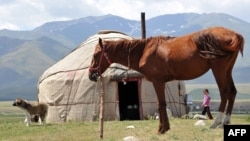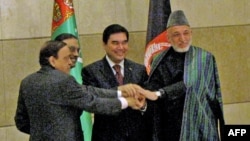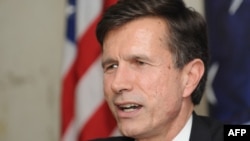Can camels and caravans be reincarnated as rail networks and oil pipelines?
That's the metaphor behind the United States' New Silk Road initiative, which aims to use energy, transport, trade, and infrastructure projects to support Afghanistan and provide regional stability after foreign troops leave the country.
In India last summer, U.S. Secretary of State Hillary Clinton called on countries to draw inspiration from the ancient Silk Road that for centuries connected the Far East and Europe.
"[Let's build] an international web and network of economic and transit connections," she said. "That means building more rail lines, highways, [and] energy infrastructure, like the proposed pipeline to run from Turkmenistan through Afghanistan through Pakistan into India (TAPI). It means upgrading the facilities at border crossings. And it certainly means removing the bureaucratic barriers and other impediments to the free flow of goods and people."
The benefits, in theory, are multifold.
Avenues would be opened for Kabul to increase regional trade, providing much-needed income to help offset the expected drop in international aid after foreign troops draw down in 2014.
Neighboring countries would be active participants in rebuilding regional ties, providing an economic foundation that could help prevent the spread of extremism.
Funding would come from the World Bank, the Asian Development Bank, the private sector, and interested governments, while the United States would use its clout to keep things moving.
The United States, well aware of fears that waning U.S. interest in the region could lead to chaos, would be able to show that it is involved for the long-term while also keeping Iranian interests in the region at bay.
Progress, But Questions Remain
This month, about one year after the initiative was launched with much fanfare, the major stakeholders will get a chance to take stock of its progress when diplomats from Afghanistan, its neighbors, and world powers meet on the sidelines of the UN General Assembly in New York.
In that time, analysts say, there have been some signs of progress toward a vision of regional interconnectivity. But they also say major questions remain about the plan's feasibility amid persistent instability, corruption, and rivalries.
S. Frederick Starr, the chairman of the Central Asia-Caucasus Institute at Johns Hopkins University, says progress "has been slower than it should have been but faster than the pessimists expected."
Starr, who was instrumental in formulating the concept behind the U.S. initiative, says Clinton is correct in describing the TAPI (Turkmenistan-Afghanistan-Pakistan-India) pipeline as one of its lynchpins.
Washington cited this spring's pricing agreement for Turkmen gas as a landmark toward making the slow-moving project more than just an $8 billion pipe dream. But huge obstacles remain, including finding private-sector investors willing to fund a pipeline that would traverse restive areas of Afghanistan and Pakistan.
Building Confidence
Starr says the U.S. government has not done enough to inspire confidence in the viability of the project, in ambitious plans for dams, power grids, and rail networks. The best way to convince governments and investors that they can be safe and profitable, he argues, is to start small.
"The key short-term issue is opening up a few key road corridors in and out of Afghanistan," Starr says. "We're only talking about four or five, which [would be] honest and fast. Exporters of cotton from Central Asia would be sending hundreds of trucks to Gwadar, Karachi, Chah Bahar, and Bandar Abbas [through Afghanistan].
"And if you do the short-term projects successfully," he continues, "confidence in the midterm projects will rise and those, in turn, will create more confidence and eagerness to invest in the long-term projects. But that hasn't been done yet."
For its part, the United States has cited recent steps to implement a transit-trade agreement between Afghanistan and Pakistan as another significant stride. If fully implemented, it could speed the transfer of Afghan goods to foreign markets and perhaps set a regional precedent.
Washington has also welcomed a move by Islamabad and New Delhi toward normalizing trade, as well as agreements between Afghanistan, Kyrgyzstan, and Tajikistan to streamline crossborder transport. Planned rail networks linking Kabul to the outside world are also slowly gathering steam.
But in practice, such deals don't necessarily remove entrenched impediments to regional trade, such as protective tariff systems and corruption.
It's not rare for Afghan imports coming through Pakistan to be held up, sometimes for months, until trade disputes are settled or unrelated bilateral tensions ebb.
Regional Rivalries
Farther north, Tajik truck driver Mahmud Bobokhonov expressed his frustration to RFE/RL's Tajik Service near the border with Kyrgyzstan.
"Kyrgyz officials think that every Tajik smuggles drugs and demand money to allow you to cross the border," he says. "Even every passenger on crossborder buses has to pay at least 100 Russian rubles to enter Kyrgyzstan. There is no oversight of border and custom guards and they do anything they want."
Sebastien Peyrouse, a Central Asia expert at George Washington University, says that in many cases Washington may not have the clout to overcome deep-seated regional rivalries.
"Most of the countries in Central Asia have bad relations. So, for example, now you see that Tajikistan is trying to sell electricity to Afghanistan, but on the other hand, Uzbekistan is putting strong pressure on Kabul so that it doesn't buy electricity from Tajikistan," Peyrouse says. "There are a lot of tensions between Central Asian countries, which can mean a real problem for further involvement in Afghanistan."
Nevertheless, U.S. officials remain bullish on the Silk Road.
"We have seen a real shift in the way that people talk about [the New Silk Road initiative]," says Robert Blake, the U.S. assistant secretary of state for South and Central Asian affairs. "It's no longer, 'How can the New Silk Road possibly happen?' Instead, it's, 'What are the linkages that can be strengthened or developed to knit these countries more closely together?'"
Washington has also stressed that its vision for the region is meant to emerge after years, not 12 months. The question, analysts say, is whether progress will have enough momentum to sustain itself after 2014.
That's the metaphor behind the United States' New Silk Road initiative, which aims to use energy, transport, trade, and infrastructure projects to support Afghanistan and provide regional stability after foreign troops leave the country.
In India last summer, U.S. Secretary of State Hillary Clinton called on countries to draw inspiration from the ancient Silk Road that for centuries connected the Far East and Europe.
"[Let's build] an international web and network of economic and transit connections," she said. "That means building more rail lines, highways, [and] energy infrastructure, like the proposed pipeline to run from Turkmenistan through Afghanistan through Pakistan into India (TAPI). It means upgrading the facilities at border crossings. And it certainly means removing the bureaucratic barriers and other impediments to the free flow of goods and people."
The benefits, in theory, are multifold.
Avenues would be opened for Kabul to increase regional trade, providing much-needed income to help offset the expected drop in international aid after foreign troops draw down in 2014.
Neighboring countries would be active participants in rebuilding regional ties, providing an economic foundation that could help prevent the spread of extremism.
Funding would come from the World Bank, the Asian Development Bank, the private sector, and interested governments, while the United States would use its clout to keep things moving.
The United States, well aware of fears that waning U.S. interest in the region could lead to chaos, would be able to show that it is involved for the long-term while also keeping Iranian interests in the region at bay.
Progress, But Questions Remain
This month, about one year after the initiative was launched with much fanfare, the major stakeholders will get a chance to take stock of its progress when diplomats from Afghanistan, its neighbors, and world powers meet on the sidelines of the UN General Assembly in New York.
In that time, analysts say, there have been some signs of progress toward a vision of regional interconnectivity. But they also say major questions remain about the plan's feasibility amid persistent instability, corruption, and rivalries.
S. Frederick Starr, the chairman of the Central Asia-Caucasus Institute at Johns Hopkins University, says progress "has been slower than it should have been but faster than the pessimists expected."
Starr, who was instrumental in formulating the concept behind the U.S. initiative, says Clinton is correct in describing the TAPI (Turkmenistan-Afghanistan-Pakistan-India) pipeline as one of its lynchpins.
Washington cited this spring's pricing agreement for Turkmen gas as a landmark toward making the slow-moving project more than just an $8 billion pipe dream. But huge obstacles remain, including finding private-sector investors willing to fund a pipeline that would traverse restive areas of Afghanistan and Pakistan.
Building Confidence
Starr says the U.S. government has not done enough to inspire confidence in the viability of the project, in ambitious plans for dams, power grids, and rail networks. The best way to convince governments and investors that they can be safe and profitable, he argues, is to start small.
"The key short-term issue is opening up a few key road corridors in and out of Afghanistan," Starr says. "We're only talking about four or five, which [would be] honest and fast. Exporters of cotton from Central Asia would be sending hundreds of trucks to Gwadar, Karachi, Chah Bahar, and Bandar Abbas [through Afghanistan].
Kyrgyz officials think that every Tajik smuggles drugs and demand money to allow you to cross the border...Truck driver Mahmud Bobokhonov
"And if you do the short-term projects successfully," he continues, "confidence in the midterm projects will rise and those, in turn, will create more confidence and eagerness to invest in the long-term projects. But that hasn't been done yet."
For its part, the United States has cited recent steps to implement a transit-trade agreement between Afghanistan and Pakistan as another significant stride. If fully implemented, it could speed the transfer of Afghan goods to foreign markets and perhaps set a regional precedent.
Washington has also welcomed a move by Islamabad and New Delhi toward normalizing trade, as well as agreements between Afghanistan, Kyrgyzstan, and Tajikistan to streamline crossborder transport. Planned rail networks linking Kabul to the outside world are also slowly gathering steam.
But in practice, such deals don't necessarily remove entrenched impediments to regional trade, such as protective tariff systems and corruption.
It's not rare for Afghan imports coming through Pakistan to be held up, sometimes for months, until trade disputes are settled or unrelated bilateral tensions ebb.
Regional Rivalries
Farther north, Tajik truck driver Mahmud Bobokhonov expressed his frustration to RFE/RL's Tajik Service near the border with Kyrgyzstan.
"Kyrgyz officials think that every Tajik smuggles drugs and demand money to allow you to cross the border," he says. "Even every passenger on crossborder buses has to pay at least 100 Russian rubles to enter Kyrgyzstan. There is no oversight of border and custom guards and they do anything they want."
Sebastien Peyrouse, a Central Asia expert at George Washington University, says that in many cases Washington may not have the clout to overcome deep-seated regional rivalries.
"Most of the countries in Central Asia have bad relations. So, for example, now you see that Tajikistan is trying to sell electricity to Afghanistan, but on the other hand, Uzbekistan is putting strong pressure on Kabul so that it doesn't buy electricity from Tajikistan," Peyrouse says. "There are a lot of tensions between Central Asian countries, which can mean a real problem for further involvement in Afghanistan."
Nevertheless, U.S. officials remain bullish on the Silk Road.
"We have seen a real shift in the way that people talk about [the New Silk Road initiative]," says Robert Blake, the U.S. assistant secretary of state for South and Central Asian affairs. "It's no longer, 'How can the New Silk Road possibly happen?' Instead, it's, 'What are the linkages that can be strengthened or developed to knit these countries more closely together?'"
Washington has also stressed that its vision for the region is meant to emerge after years, not 12 months. The question, analysts say, is whether progress will have enough momentum to sustain itself after 2014.














